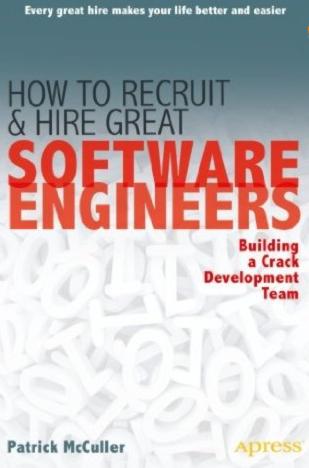| How To Recruit And Hire Great Software Engineers |
Author: Patrick McCuller There are two sides to landing a job - this book is written for those who are trying to recruit developers. This book is by a software development manager who is experienced as a hiring manager and in the task of recruiting software engineers and is aimed at others who are new, inexperienced or unsuccessful in this role. The scope of the book, who should read it and how to read it, is outlined in its Introduction - which is within the body of the book as Chapter 1. The book is described as "modular" - you don't have to read it cover to cover but can jump to the content you need and there is a handy guide to where to jump to answer specific questions - except that the numbering is out by 1 in each case. Here's the corrected version:
Chapter 1 also sets the tone for the book. Patrick McCuller repeatedly mentions he takes "an engineering approach" and tells us that that the principle he has had most success with is to treat candidates as customers. He ends the chapter: "treat candidates as human beings". Chapter 2: Talent Management focuses on hiring only the best engineers and starts by making a distinction between two categories of tools required to build software products - immediate tools, i.e. those required for the current set of goals and capability tools required further down the line. McCuller advises that you should hire those with the latter - i.e. with the ability to learn, master and teach new programming languages, techniques and platforms. He then goes on to make the case for hiring only top performers and looks at personality types, making a distinction between Creators who like to start things and Optimizers who like to tweak existing things. This chapter concludes with an interesting discussion about compensation - the danger of paying too much.
Chapter 3: Candidate Pipeline has helpful flow diagrams to illustrate the recruitment process from different points of view and advocates using a spreadsheet to keep records that identify reasons for rejection and also the time lapse involved in the process to avoid the possibility of your ideal candidate taking up an alternative job offers due to the length of the process. Returning to the "Candidate as Customer" theme McCuller points out that your reputation as a company will be spread by the majority of candidates who are the ones you turn down for one reason or another. Chapter 4: Finding Candidates looks at job descriptions before classifying candidates. It points out that those who are active job seekers include a large number of undesirable hires. On the other hand, the group of passive candidates who are "sort of looking" are less likely to accept an offer. The group of "Open" candidates, who are at least prepared to talk about a job, are tough to hire because they aren't looking for a new job but are probably highly capable. "Closed"candidates don't even want to consider a job at present while "Upcoming"candidates - fresh graduate students, those returning to the developer workforce represent a good source of hires if you can wait for them. The rest of the chapter looks at career portals, jobs boards, referrals, working with recruiters, using your network. There's a section on eliminating prejudice - gives ways to attract talented candidates. Chapter 5: Resumes not only goes through what McCuller looks for and what feedback he provides to their sourcers or recruiters hew works with, it provides "worked examples" of two resumes - one that was accepted and another that was rejected.
Two chapters are then devoted to the interviewing process and its questions and if you are someone who is looking to be hired you will find much of interest in them. Chapter 6 starts by returning to the idea of the candidate as a customer and that your company's reputation is at stake in the interview process and to highlight this McCuller relates the personal horror story about a phone screen experience. Next we look at the roles required for the hiring process and the interview structure is discussed. The chapter concludes with different scenarios for the actual interview. Chapter 7 is about interview questions of what they are designed for. It covers coding questions and after a discussion of how they should be designed presents a few examples. Chapter 8 looks at the next step in the process, making hiring decisions. For anyone he feels unsure about making a choice between candidate this is a must-read chapter. which outlines who not to hire and includes real-world stories. Chapter 9: Offers is short. It gives the advice p.196 "when you build and present an offer you’re selling a situation" and it reminds you to include opportunities such as daily technical challenge and opportunity to use/learn expert skills and work with other experts and with a fantastic manager - and then looks into ways of communicating how great you are without seeming to be an egomaniac - the advice is to tell potential recruits to ask other people. Chapter 10 is about getting newly hired engineers off to a great start. It suggests how to make someone who has relocated feel welcome and how to to integrate new hires into the team. There are plans not only for the first week, but also for the first month, first quarter, and first year Koch. The idea of a peer mentor is introduced. The book rounds out with three appendices that will be useful whichever side of the interview process you are one:
Although this book isn't aimed at those seeking jobs, there's material throughout it that they will find useful. From the point of view of the new or inexperienced hiring manager this is an excellent handbook. Recommended
|
|||
| Last Updated ( Friday, 25 May 2018 ) |


